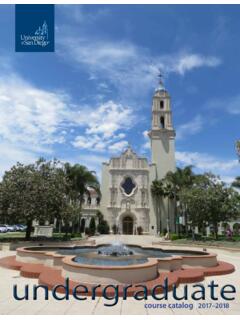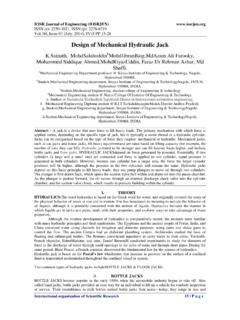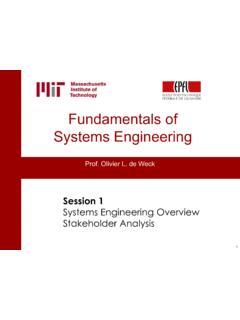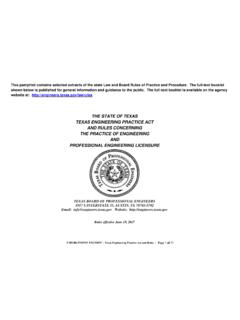Transcription of Water Purification Project
1 COOL. Water Purification Project August 1, 2007. To Whom It May Concern, Water may be the world's most abundant resource, but the need for sanitary and clean Water is exponentially increasing. Currently available Water Purification systems require large scale expensive facilities or disposable filters which require costly maintenance and replacement. Deaths in developing countries and rural areas have increased in the past ten years due to lack of clean Water , and countries such as the United States have pledged to give over a billion dollars towards Water related fields. Around the world there is a growing need and interest in clean Water .
2 Attached is a proposal for a simple inexpensive Water Purification system. This device will be reusable, require little maintenance and contain minimal degradable parts. This is accomplished by using a windmill to translate mechanical input to electrical power. Heat created by a heating element boils Water and removes of all bacterial impurities. The proposed system will be competitive in the world market and most practical for non-industrial sized applications. Sincerely, Cheryn Engebrecht Ian Metzger Matthew Petrucci Colin Porterfield COOL. Water Purification Project design Report Cheryn Engebrecht Ian Metzger Matthew Petrucci Colin Porterfield Executive Summary The COOL Water Purification Project uses two sources of energy to create potable Water .
3 For normal uses, wind will be used as a renewable energy source and for emergency situations a human powered mechanism provides an alternative energy source. This system will boil contaminated Water , purifying it, and then condense the Water as a potable source. The system will be simple, cost efficient, and require minimal maintenance. Abstract The goal of the COOL Water Purification Project is to make potable Water using two sources of energy. For everyday use, the mechanism uses wind as a renewable energy source. Additionally, a human powered prototype was constructed and tested for the 2007 ASME design Competition. Both cases convert mechanical power to electric power through the use of a generator.
4 Electric current is run to a heating element located in the contaminated Water , transferring heat, causing it to boil. The evaporated Water leaves behind of contaminants in the boiler producing mostly uncontaminated vapor. The Water vapor created then condenses through a concentric tube heat exchanger and the result is potable Water . The system will efficiently transmit heat to the Water and all components of the device will be cost efficient and require minimal maintenance. Acknowledgements Dr. McGarry Thank you for your encouragement and understanding. We appreciate all of the great advice on the heat exchanger and your dedication to making this class useful for our long- term professional development as well as our technical writing skills that we have all gained.
5 Dr. Malicky Thank you for never giving up on us. You more than anyone else have helped our Project become a success (especially in the days prior to the competition). Thank you for letting us take over your machine shop when we needed it and for helping us make last minute adjustments that were essential in our projects' success. Other Mechanical engineering Faculty Thank you for your assistance and expertise in all aspects of engineering . We appreciate your help, support, and interest in our Project . Table of Contents Table of Contents .. 1. Table of Figures .. 2. Concept .. 4. Background .. 5. Professional and Ethical Responsibility of Project .
6 6. Lifelong Learning Contribution of Project .. 7. Global, Economic, and Environmental Impact .. 8. Purpose and Overview of Project 9. Literature 10. System Description .. 13. Diagrams of End Result .. 15. Specifications .. 23. Functional Description .. 25. Testing and Evaluation .. 50. Does design Meet design Requirements? .. 54. Accomplishments .. 57. Future Work .. 59. Budget .. 61. Schedule .. 64. References .. 65. 66. A Technical Drawings .. 66. B ASME design Competition Rules .. 77. C Syringe and Valve Calculations .. 80. D Human Power vs. Wind Power Time to Boil .. 81. E Windmill Specifications Sheet .. 82. F Heat Exchanger Constants.
7 84. G Personnel / Organization Chart .. 85. 1. Table of Figures Figure 1: Common Brita Water filter .. 10. Figure 2: Reverse osmosis diagram .. 10. Figure 3: In-home reverse osmosis system .. 11. Figure 4: Desalination plant .. 11. Figure 5: Desalination process using pressure/membrane 11. Figure 6: Comparative costs of RO desalination .. 12. Figure 7: 13. Figure 8: Syringe and valve low-pressure mechanism .. 14. Figure 9: Bike stand assembly .. 15. Figure 10: Generator efficiency test rig .. 15. Figure 11: Flexible shaft coupling .. 16. Figure 12: Air-X Windmill .. 16. Figure 13: Loma Hall .. 17. Figure 14: Windmill generator test 17.
8 Figure 15: Windmill stand .. 18. Figure 16: Boiler .. 19. Figure 17: Double pane insulation system .. 20. Figure 18: Flow control .. 20. Figure 19: Nichrome resistance wire .. 21. Figure 20: Heat exchanger .. 21. Figure 21: Heat exchanger cross-section .. 22. Figure 22: Overall system diagram .. 22. Figure 23: Windmill generator test 28. Figure 24: Wire gauge sizing table for average wind speed of 11 mph .. 29. Figure 25: Windmill Water Purification system circuit 30. Figure 26: Resistor efficiency test .. 30. Figure 27: Resistor efficiency at low wind speeds .. 31. Figure 28: Resistor test power curve .. 32. Figure 29: Air-X marine windmill power curve.
9 32. Figure 30: Wind speed chart versus voltage output .. 33. Figure 31: Stand on the Loma roof .. 33. Figure 32: Free body diagram of stand .. 34. Figure 33: Telescoping pole joint .. 35. Figure 34: Windmill joints .. 36. Figure 35: Windmill 36. Figure 36: Boiler 38. Figure 37: Boiler connection method .. 38. Figure 38: Thermal efficiency calculations .. 39. Figure 39: Boiler exterior design .. 39. Figure 40: Interior design of boiler .. 40. Figure 41: Float prototype .. 41. Figure 42: Flow control free body diagram .. 42. Figure 43: Final float design .. 42. Figure 44: Buoyancy 43. 2. Figure 45: Spring constant evaluation.
10 43. Figure 46: Change in x at the three pivot positions .. 43. Figure 47: Flow mechanism forces .. 44. Figure 48: Flow mechanism force ratio .. 44. Figure 49: Solid sections of the heat exchanger .. 46. Figure 50: Tube length calculations .. 47. Figure 51: Contour plot of approximately the first two meters of the heat exchanger in 47. Figure 52: Temperature diagram of Water and vapor in relation to the position along the tubes. 48. Figure 53: Overall heat exchanger configuration .. 49. Figure 54: Heat exchanger temperatures .. 53. Figure 55: Close-up view of boiler connections to heat exchanger .. 55. Figure 56: Old heat exchanger.







